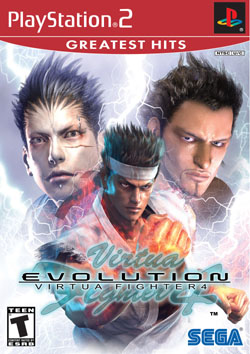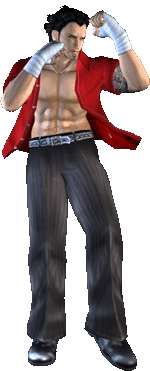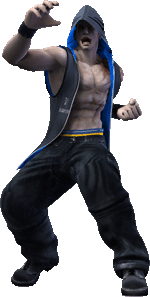
|
|
||

| Developer: Sega AM2 | Publisher: Sega |
| Type: Fighting | Players: 1 - 2 | ||
| Difficulty: Intermediate | Released: 08-13-02 |
 Some call Virtua Fighter 4 Evolution a full-blown sequel. Others would just say that itís a very good upgrade to a game that was nearly perfect in the first place. What you wonít be hearing is anyone saying that they would prefer the original VF4 to VF4e. It hasnít happened and odds are it wonít happen anytime soon. Released almost one year ago in the arcades (ironically it has faced Namcoís Soul Calibur 2 on both of its releases), Evolution is the fully charged follow-up to the first Virtua Fighter game ever released on a non-Sega system, which sold over one million copies world-wide. For the uninitiated, it might be a good idea to read up on our Virtua Fighter 4 review for a breakdown on what has been added to the series, as the basic engine of Evolution uses the exact same one from the original game. As far as techniques such as Exact Recovery and the ARM system are concerned, veterans of VF4 will have no problem adjusting to Evolution. What has been changed is just about everything else. Every stage in the game has received a visual and aural upgrade that make them so different from the first game that Sega actually included the original stages as a bonus. For example, Lauís stage in the original VF4 consisted of a flat arena with various puddles of water indicating that a rainstorm had just occurred. In Evolution, you actually fight in said storm, with every action you take kicking up water into the air. Even then, AM2 was not content with mere cosmetic changes and went the extra mile to change the layout of several arenas in the game. For stages such as Lionís castle or Jackyís rooftop, they are no longer enclosed with a barrier that encircles the entire perimeter. Instead each corner of the arena is exposed and can lead to ring outs, something that wasnít possible most of the time. Even the characters themselves have a few cosmetic changes to them, such as Sarah and Jeffryís new neutral stances. The biggest changes to the graphics is the infinitely smoother look as well as the incredibly fast loading times. In VF4, it could take up to 20 seconds to start a match, but in Evolution that time is cut in half. This is largely thanks to the fact that Sega has released the game on a DVD disc rather than the CD format Sega used for the first game. As with all the other VF games, Evolutionís animation is top notch, easily surpassing Tecmoís Dead or Alive series and arguably Namcoís Tekken and Soul games. Check out Shun Diís 10DP Sabaki for an example of how amazing the animation is in this game. Itís rare to have a game that looks this good, yet plays even better. The only hit that anyone could make on the graphics is the fact that during the stage flybys there can be some jittering and slowdown due to the loading, but given the benefits of this (less wait for your match) I doubt anyone would complain. The evolution of the game can not only be seen in its graphics, but in the gameplay. While the basic foundations of the game have stayed the same since the first VF4, there have been so many changes to each character that it could take the average gamer weeks to get accustomed to all of the changes for the characters that they use. For old characters like Akira, this means new moves to brutalize your opponent with, such as a combo string where he will perform a dashing elbow immediately into a single palm strike for impressive damage. He also has a cool variant on his infamous Dragon Lance Combo where heíll perform the first two moves of the string and then sidestep, giving this move more versatility than ever before. Other characters such as Vanessa have gotten complete makeovers that will make learning them again even more enjoyable the second time around. Overall, every character has gotten plenty of new moves for players to mess around with, and some of the more Ďsimplisticí characters such as Lau and Pai have received new stances that make them even more dangerous.
Replacing VF4ís stellar Kumite mode is Quest mode, which works a lot like Kumite but has some very significant changes to it. The most obvious change is that Quest mode sets you on a map of Tokyo and allows you to go to many of the famous arcades in the city to challenge opponents and win prizes. Like in Kumite, you can customize the look of your character with the accessories that you win in Quest mode. Although there are items from VF4 that make an appearance here, the large majority of items that you can win are completely new. Not to mention that they make your character look absolutely ridiculous. Once youíve seen Lau with his chefís hat or Goh with his hooded jacket complete with a clown face, youíll understand why people have so much fun dressing up their characters. In every arcade you can compete in tournaments to win a prize and to unlock the next arcade on the map. In order to enter a tournament you must first meet a certain condition, such as winning 30 games or beating the top 3 players at that location. The tournaments themselves are a basic single elimination format but become extremely hard once you get to the later arcades. Each arcade has a series of Quest Orders that you can complete in order to receive additional prizes, such as money or accessories. These Quest Orders can be really easy ('Land 40 counterhits') to downright tough ('Win 2 matches in a row without guarding'), but they all attempt to challenge the player into becoming a better player by forcing them to use techniques that you have picked up earlier. And this is the beauty of VF4 and VF4 Evolution. Unlike every other fighting game that forces you to learn everything by yourself, the training modes and tutorials in VF4 Evolution are second to none. Whether youíre using Command, Trial, Free or Guide Training, thereís always an option for players to continue learning the fundamentals of the game as well as advanced techniques like 'Evade Double Throw Escape Guard'. Itís nice to know that Sega realized how quickly the learning curve ramps up in this game and made sure that everyone who makes this purchase will have no excuses if they complain that the game is too hard.
The question then becomes 'what happens if you want to load a character from the other memory card slot?' Since everything is in one big file instead of separate file for each customized character, the game will not be able to extract the character data from a separate save file. For some people this might be considered a huge mistake on Segaís part, but it only affects those who play the game in big groups, since itís impossible to keep track of how many wins each player has. However, this isnít a big deal when you think about it. Most people who play in big groups will definitely know who dominated on any particular day. And for those who only play with two or three friends, this wonít affect you either. Another problem with the game is Quest modeís Quest Orders. It wouldíve been nice to be able to select different Quest Orders while playing if you have finished one already. In the game you have to exit your current game to change the Quest Order to something else once you have finished it. The experience of Quest mode would have been much more streamlined if you were able to choose the next Quest Order from a menu in-game. In the end, any minor problems with Virtua Fighter 4 Evolution cannot outweigh what youíre getting in this package, which is priced at a mere 20 bones. Not only do you get the deepest fighting game on the planet with some of the best graphics on the PS2, you also get an extremely satisfying single player mode that will keep you occupied for months. On top of that, North American players also get the benefit of receiving Virtua Fighter 10th Anniversary, a special mode that combines Virtua Fighter 1 and VF4 Evolution for one slick homage to the series that started it all. Given the price and the completeness of this package, I find it odd that I even have to write a review recommending this game to anyone. No PS2 owner should be without this title. |

|
| Graphics: 9 | Sound: 7 | ||
| Gameplay: 10 | Replay: 10 |
†
†
 Of course, we canít forget the two new characters that have been introduced. Brad Burns is a Muay Thai fighter that possesses a scary arsenal of elbow and knee strikes that can really put a dent in your opponent. Not only that, but he can also weave and bob to dodge attacks like the best pugilists of our time. While comparisons will obviously be made to Tekken 4ís Steve Fox, itís obvious to anyone who has played both characters that they are completely different and only share similarities with their ducking/swaying stances. The second new character is Goh Hinogami, a judo expert who is an assassin for the organization J6. Billed as a true opponent to Akira, Goh plays unlike any of the Virtua Fighter characters seen before, using a small set of attacks to complement his extremely potent throwing ability. In a way, Brad and Goh are pretty much polar opposites of each other; where Brad needs to maintain a flow of attacks in order to be successful, Goh path to victory is based on his ability to punish his opponents with an ungodly amount of throws. In any event, what has made Virtua Fighter such a tremendous hit worldwide has always been its ability to wow people with its superior graphics and then reel them in with a game thatís satisfying to learn. That quality is not lost on Evolution, as the game is even deeper than before with the inclusion of Brad and Goh, not to mention all of the new moves added to the game.
Of course, we canít forget the two new characters that have been introduced. Brad Burns is a Muay Thai fighter that possesses a scary arsenal of elbow and knee strikes that can really put a dent in your opponent. Not only that, but he can also weave and bob to dodge attacks like the best pugilists of our time. While comparisons will obviously be made to Tekken 4ís Steve Fox, itís obvious to anyone who has played both characters that they are completely different and only share similarities with their ducking/swaying stances. The second new character is Goh Hinogami, a judo expert who is an assassin for the organization J6. Billed as a true opponent to Akira, Goh plays unlike any of the Virtua Fighter characters seen before, using a small set of attacks to complement his extremely potent throwing ability. In a way, Brad and Goh are pretty much polar opposites of each other; where Brad needs to maintain a flow of attacks in order to be successful, Goh path to victory is based on his ability to punish his opponents with an ungodly amount of throws. In any event, what has made Virtua Fighter such a tremendous hit worldwide has always been its ability to wow people with its superior graphics and then reel them in with a game thatís satisfying to learn. That quality is not lost on Evolution, as the game is even deeper than before with the inclusion of Brad and Goh, not to mention all of the new moves added to the game.
 What people will probably complain about is the medicore soundtrack for the game. Virtua Fighter 4 had a nice collection of tunes that were distinct from each other and really fit the mood of each stage. For Evolution theyíve been replaced with new tracks that really donít fit well with the arenas, despite being upbeat. While the old tracks are still in the game, you can only use them with the old stages. What could be considered a glaring problem with Evolution is the memory card system. Unlike VF4ís save system that had separate files for each character you created, VF4 Evolutionís save file saves everything in one big file, which includes two slots for each character to store. For example, two versions of Pai will both show up when you put the character select cursor on Pai. Doing it this way allows both players to load from the same memory card, and when the game needs to save the data, it will only have to save one file on one card, thus reducing the save time by half.
What people will probably complain about is the medicore soundtrack for the game. Virtua Fighter 4 had a nice collection of tunes that were distinct from each other and really fit the mood of each stage. For Evolution theyíve been replaced with new tracks that really donít fit well with the arenas, despite being upbeat. While the old tracks are still in the game, you can only use them with the old stages. What could be considered a glaring problem with Evolution is the memory card system. Unlike VF4ís save system that had separate files for each character you created, VF4 Evolutionís save file saves everything in one big file, which includes two slots for each character to store. For example, two versions of Pai will both show up when you put the character select cursor on Pai. Doing it this way allows both players to load from the same memory card, and when the game needs to save the data, it will only have to save one file on one card, thus reducing the save time by half.




